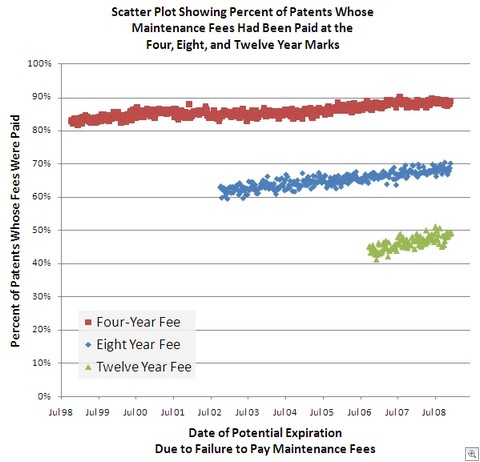A large portion of PTO revenue comes through applicant’s payment of maintenance fees. Under the current fee structure, three post-grant maintenance fees must be paid in order to keep a patent from prematurely expiring. A large entity pays $980 3.5 years after issuance; $2,480 7.5 years after issuance; and $4,110 11.5 after issuance. If the fee is not paid then the patent will expire at the next 4, 8, or 12 year mark. In FY08, the PTO reported over $500 million in revenue from maintenance fees.
I wanted to look at how maintenance fees are being paid, so I downloaded the past decade of OG Notices and parsed-out notices of patent expiration. The chart below shows some results.
The chart shows survival rates for the four (red), eight (blue), and twelve (green) year marks. Each datapoint represents the average survival rate for patents that would have expired on that date. For instance, of the 2229 utility patents that issued on December 31, 1996, the first fee was paid for 84% of the patents, the first two fees were paid for 63% of the patents, and all three fees were paied for 49% of the patents. (Note – I did not yet add-back cases that were revived due to unintentional abandonment.)
The median patent has an ordinary enforceable term of about 17 years. This is based on the twenty year term which begins at filing of the non-provisional application minus three years of prosecution. If prosecution takes longer than three years, then the term will likely be extended under the PTA provisions.
However, this data shows that the median patent term is actually cut short by about five years because applicants decide not to pay the large final fee.
A third feature to recognize from this chart is that the percentage of patents whose fees are being paid is increasing over time. However, the PTO has indicated that it expects a drop in maintenance fee payments due to the economic slump.
Judge Moore looked at expiration data for patents issued in 1991 in her paper on “Worthless Patents.” Her result is that patents were more likely to “survive” (i.e., have their maintenance fees paid) when they have more claims, more art cited, more related applications, and longer prosecution times. US corporate owners were more likely to pay the fees than individual or foreign owners. She also found that Semiconductor and Optics patents were the most likely to survive. Amusement patents were unlikely to survive.
